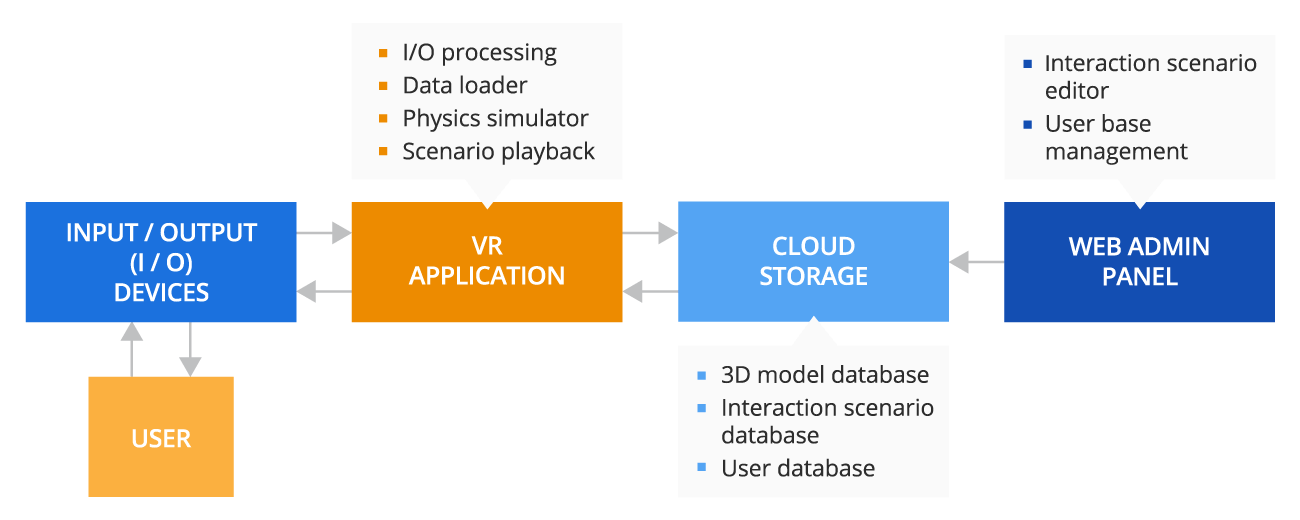Virtual Reality in the Automotive Industry: Market, Adoption, Use Cases
ScienceSoft leverages 36-year experience in developing immersive software and 17 years in the automotive industry to provide dedicated VR consulting and VR app development services.
Virtual Reality in the Automotive Industry: Market Summary
Virtual reality software allows reducing the costs of R&D and manufacturing, increasing sales, and minimizing driving risks by moving prototyping, showcasing, and test driving to the virtual realm. In 2019, the global VR market in the automotive industry accounted for $759.3 million and is forecasted to grow up to $14,727.9 million by 2027 at a CAGR of 45.1%.
VR Adoption in the Automotive Industry
North America is the biggest shareholder of the global automotive VR market. While Tesla advertises its cars by offering customers virtual rides, Ford Motor Company develops a VR training tool for polishing the skills of its technicians. Germany continues to be the leading automotive VR adopter in Europe, with Volkswagen reducing design costs via virtual prototyping, BMW increasing sales thanks to immersive showrooms, and Audi enhancing the safety of self-driving cars manufacturing by performing testing in virtual reality.
The key drivers of the increasing automotive VR popularity are technological advancement and the need to reduce engineering costs.
Automotive VR Software Architecture
The architecture of VR applications in the automotive industry varies depending on the application type. Yet in all cases, the VR solution architecture includes the following 3 components:
A client VR application
with modules responsible for processing input, generating output, building 3D models of cars and applying the laws of physics to their surfaces, as well as running interaction scenarios.
A database
that stores 3D car models, VR interaction scenarios, and user data.
A web administration panel
which allows access to the content in the database and thus, data modification in the client app.

Use Cases of VR in the Automotive Industry
VR in automotive industry creates a room for quick experiments in vehicle prototyping and a safe environment for technician trainings and test drives.
VR for Vehicle Prototyping
With VR, there’s no need to spend time and effort on the complicated process of building bulky physical prototypes. Virtual prototyping also simplifies research and development, speeds up the design process, and reduces the number of adjustment rounds, thus significantly cutting the costs on the entire pre-manufacturing cycle.
How VR for vehicle prototyping works: When full-scale 3D samples of vehicle parts or complete vehicle models are placed in the virtual reality, designers can easily manipulate them and quickly tweak according to safety regulations, design requirements, or stakeholders’ requests.
Use cases:
- Pre-manufacturing design and approval.
- Virtual testing of self-driving car prototypes.
VR for Training in the Automotive Industry
Virtual reality training software is useful for both manufacturing and after-sales. It can be a part of original equipment manufacturers’ corporate training programs to ensure quick onboarding and proficiency matching a brand image. VR training can also be an offer to potential car buyers, who would appreciate effective and safe VR driving lessons on specific car models (e.g., autonomous cars).
How VR for training works: A user can drive or perform maintenance on a virtual vehicle just like they would do with a physical one – save for the risks of causing any damage to both humans and vehicles. To ensure better results, the VR app can include textual, visual, and audio guidance.
Use cases:
- Technician training.
- Vehicle operation learning.
VR for Auto Showrooms
Virtual reality technology can become a sales-boosting mechanism for car manufacturers and dealers. They have the opportunity to raise online sales via virtual showrooms, where potential customers will inspect 3D cars’ exterior and interior and have a test drive – all without leaving their homes.
How VR immersive showrooms work: A showcased virtual car is a complete and detailed replica of the physical model. Still, a customer can easily modify certain elements – e.g., the color of exterior or the material of interior – to understand what combination or variant they like best.
Use cases:
- Remote immersive tours.
- Virtual test drive.
Technologies
VR in the Automotive Industry: Consulting and Development by ScienceSoft
With 36 years in immersive software development and the extensive automotive industry knowledge, ScienceSoft is your insightful consultant and a trustworthy development vendor.
Automotive VR: consulting
- Assistance with a VR software concept.
- Development road-mapping.
- Design of a scalable architecture.
- Technology stack definition and optimization.
- Planning of integration with required hardware devices and software products.
Automotive VR: development
- Business analysis and research.
- VR software architecture design.
- UX and UI design.
- 3D modeling.
- VR development and testing.
- Integration with required hardware devices and software products.
- Software maintenance and continuous evolution.
About ScienceSoft
ScienceSoft is an IT consulting and software development vendor that was founded in 1989 and is headquartered in McKinney, TX. Employing mature quality and data security management systems that are backed by ISO 9001 and ISO 27001 certificates, we implement high-grade VR software for the automotive industry. Achieving project goals in spite of time and budget constraints, as well as changing requirements, is ScienceSoft's top priority. You set goals, we drive the project to fulfill them.






